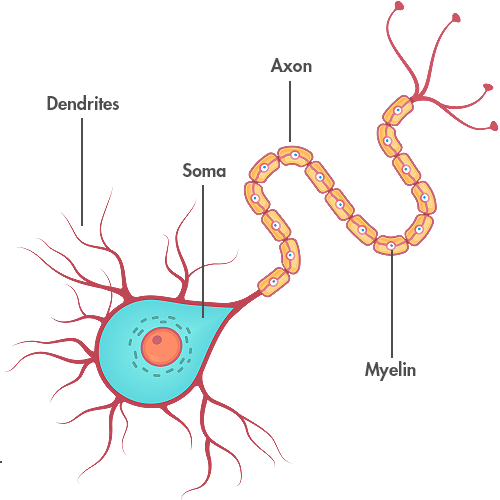Neuronal Firing
 The process of normal neuronal firing takes place as a communication between neurons through electrical impulses and neurotransmitters. To better understand this process, it is important to understand the parts of a neuron, including the soma, dendrites and axons. The soma can be thought of as the "brain" of the brain cell, as it processes the input/information into the cell and determines if it is important enough to pass along to another cell. The dendrites are tree-like structures that receive and gather information from other neurons for delivery to the soma, where the information is processed and as mentioned, the determination is made whether it is important enough to pass along to other neurons. Such information is passed from neuron to neuron via the axons, which act like the cable or wires in your house. In addition, axons are insulated, similar to electrical wires, with a fatty substance called myelin, to keep electrical current strong and flowing directionally.
The process of normal neuronal firing takes place as a communication between neurons through electrical impulses and neurotransmitters. To better understand this process, it is important to understand the parts of a neuron, including the soma, dendrites and axons. The soma can be thought of as the "brain" of the brain cell, as it processes the input/information into the cell and determines if it is important enough to pass along to another cell. The dendrites are tree-like structures that receive and gather information from other neurons for delivery to the soma, where the information is processed and as mentioned, the determination is made whether it is important enough to pass along to other neurons. Such information is passed from neuron to neuron via the axons, which act like the cable or wires in your house. In addition, axons are insulated, similar to electrical wires, with a fatty substance called myelin, to keep electrical current strong and flowing directionally.
Abnormal neuronal firing can occur when the signals between neurons are somehow disrupted. Such a problem commonly occurs in the presence of "axonal shearing" as the structure and connection of the axon with cell body is disrupted or "sheared" from the cell body by trauma forces. This creates damage to the axons so they are no longer able to communicate with neurons and the connection is lost, causing information to "get stuck" as it cannot be effectively passed on. Because of this, a neuron that is no longer able to receive input from lost connections will likely end up dying, unless it is able to establish a new connection with another neuron. Symptoms of Diffuse Axonal Injury or DAI in a patient may manifest clinically in slow speed of processing, or for example, requiring increased time to hear what is being said, such as question, process that information, formulate a response and then, articulate that response.
< What is Neurplasticity Last | Next How Neuroplasticity Works >

